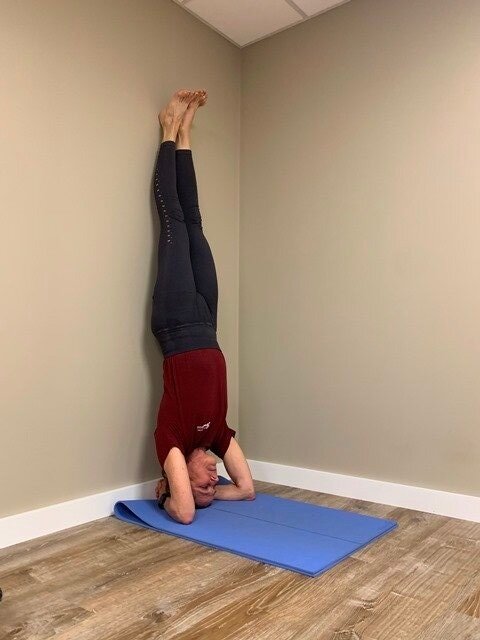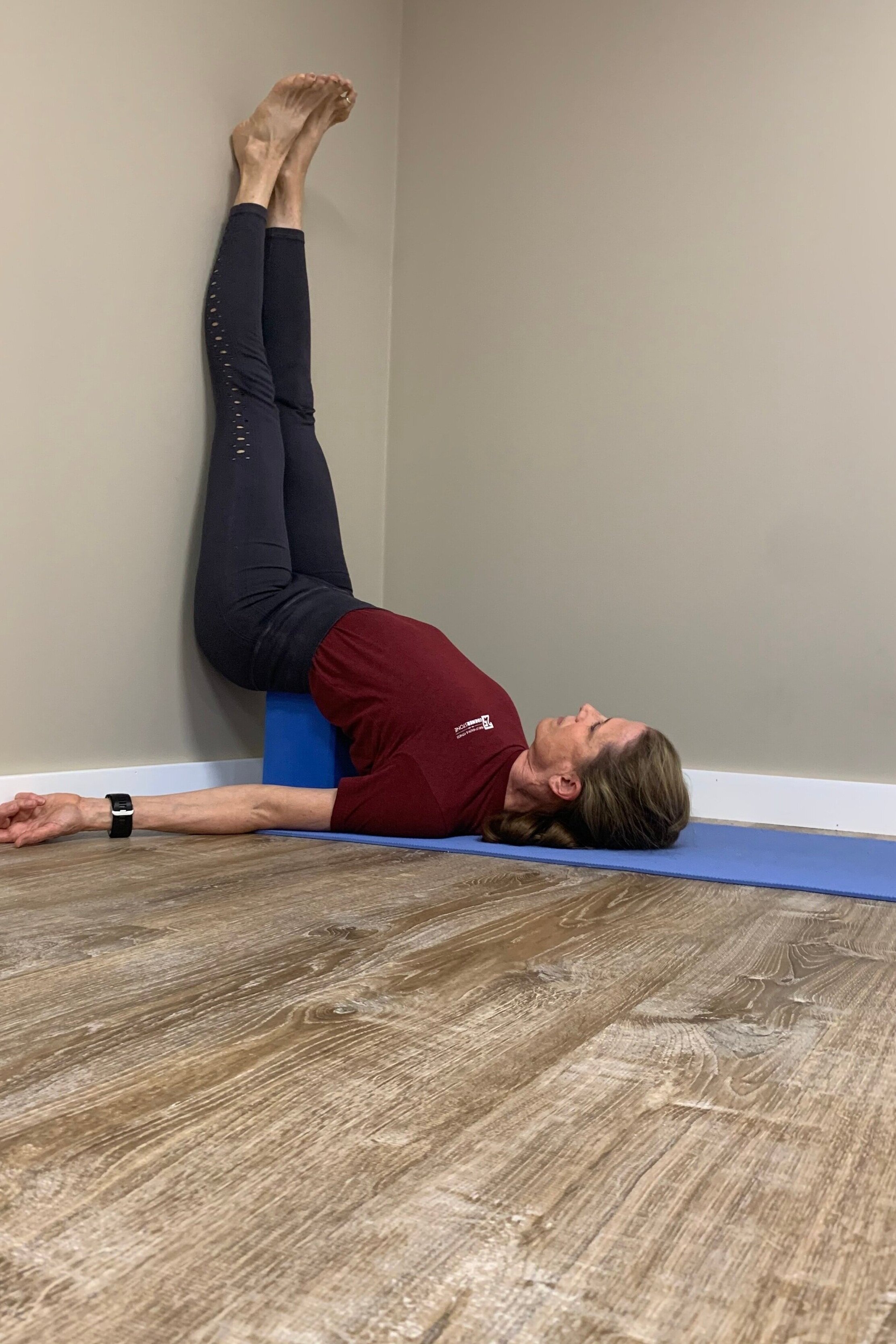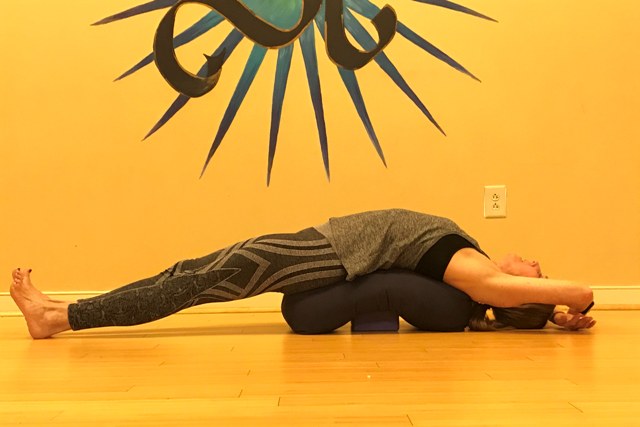Legs-Up-the-Wall: Not an Alternative to Headstand
I don’t recommend Legs-Up-the-Wall Pose as an alternative for Headstand or Handstand. The energy of these poses is very different. Every pose has an energy associated with it. You can look up the effects of each pose in Light on Yoga, or even google it online. But, I recommend that the next time you are in a pose, feel the energy of it. This is mandatory if you are a yoga teacher.
Do Head Stand, if that is in your repertoire (please do appropriate warms ups before just popping up into Sirsasana!) and, after a brief rest in Child’s Pose, do Legs-Up-the-Wall Pose. Compare and contrast the two poses. How similar are they? How different?
Sirasasana I at the wall
Legs-up-the-wall-pose
Head Stand is a fiery, invigorating pose that requires strength, stamina and focus. Legs-Up-the-Wall Pose is quieting, cooling and nurturing. The only thing they have in common is that the feet are above the head and heart.
I know a lot of teachers will recommend Legs-Up-the-Wall as an alternative for Headstand or even Handstand, but I would not suggest that. Read my blog post here for alternative postures for Headstand.
Legs-Up-the-Wall Pose is a better modification for Shoulder Stand Stand because Shoulder Stand is also quieting, cooling and nurturing. After practicing Head Stand you are still in the frame of mind to do poses that are more active. After practicing Legs-Up-the-Wall Pose, you are probably ready for Savasana. Try these two poses: do Shoulder Stand and then come down and rest and then do Legs up the Wall. See how they are energetically more alike?
Shoulder Stand is a quieting and nurturing pose
So is Legs Up the Wall Pose
As a teacher, it is important to make sure to guide all students through the same energy levels during a class. Your choreography and sequencing should raise the energy towards an apex at the middle of a class and then gradually decline towards quiet as you move into Savasana. Having the energy yo-yo back and forth can be irritating to the nervous system. As a student, it is important to pay attention to what modifications you are being guided towards so that you are still working at the same energy level as the rest of the class.
If Legs-Up-the-Wall Pose isn’t a good alternative for Head Stand, then what is? I recommend lying Supine over cross-bolsters (or a bolster with a block crosswise underneath)*. In this pose, the back of the head and the back of the heels are on the floor. Make sure the back of the neck is long and not contracted. The thighs are belted to keep the legs together. The arms are hand-to-elbow overhead with the forearms resting on the floor.
Cross bolsters, or in this case, bolster over a block*. This is a good alternative to Head Stand, especially for people who do not want to invert.
Some of my students immediately question this modification as it is a supine pose. But, again, you have to try it and feel the energy of it. Because it is a back bend, it is more energizing than Legs-Up-the-Wall Pose which falls into the forward bend category because of flexion at the hips. There is also the work of keeping the legs together which is similar to the work you feel keeping the legs together in Sirsasana. And, with the back of the head resting on the floor, it has the same grounding effect as Head Stand. Two students, one doing Sirsasana and one doing this cross-bolster pose will feel more similar afterwards than if one of them was doing Legs-Up-the-Wall Pose. Try it for yourself and see.
Also, please note, if you have your period, you should not be inverting and Cross-Bolsters Pose is a perfect alternative.
(*I sometimes have to be creative with props. If a studio does not have enough bolsters for everyone to have 2, then I will use a block and a bolster. Also, sometimes 2 bolsters are too high for a student. Whenever you are feeling compression in the low back during a back bend, one of the things you can do is to reduce the height of the props. I often use a skinny bolster crossed over a thin folded blanket for those who complain that their back is feeling pinched in this pose.)
Maybe next week, I will address the pose of Legs-Up-the-Wall Pose. There is an important consideration of the orientation of the pelvis in this pose that I often see misunderstood. And, eventhough Shoulder Stand was the pose of the month last month, I can see that I still need to address the modifications for Shoulder Stand: Legs-Up-the-Wall Pose and Supported Setu Bandha (or Supported Bridge Pose).
If you have any questions or comments, please feel free to respond in the comment section below. I use the questions for future blog posts.
Also, if you enjoy learning more stuff like this, consider enrolling in my Teacher Training Program. The next one begins in September 2019. Not everyone who enrolls in the program wants to go on to teach. Some students take it for their own personal development. You can always take just the 4 weekends of Foundations where we learn about the postures, or you can take the 4 weekends of Anatomy. However, I personally feel that the best way to learn something is to learn how to teach it. In that case, The Art & Craft of Teaching portion of the program is a must! See me for more details.






